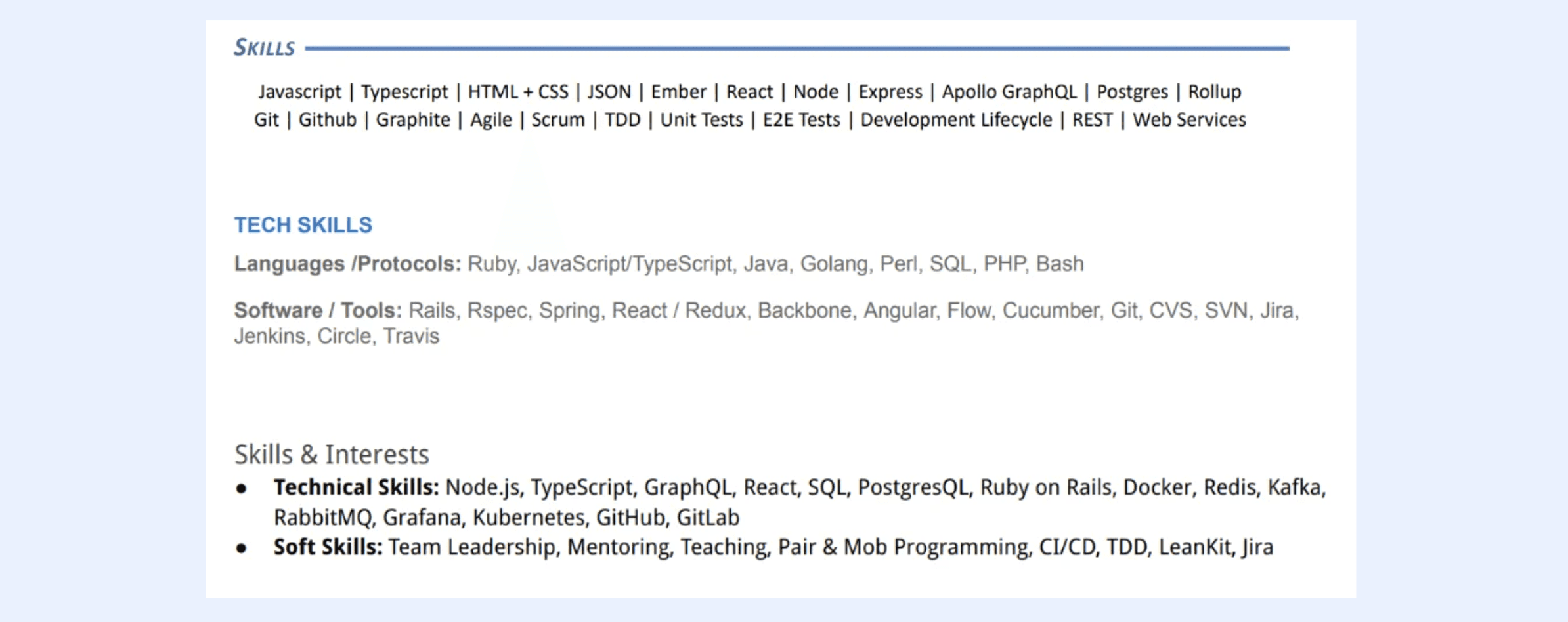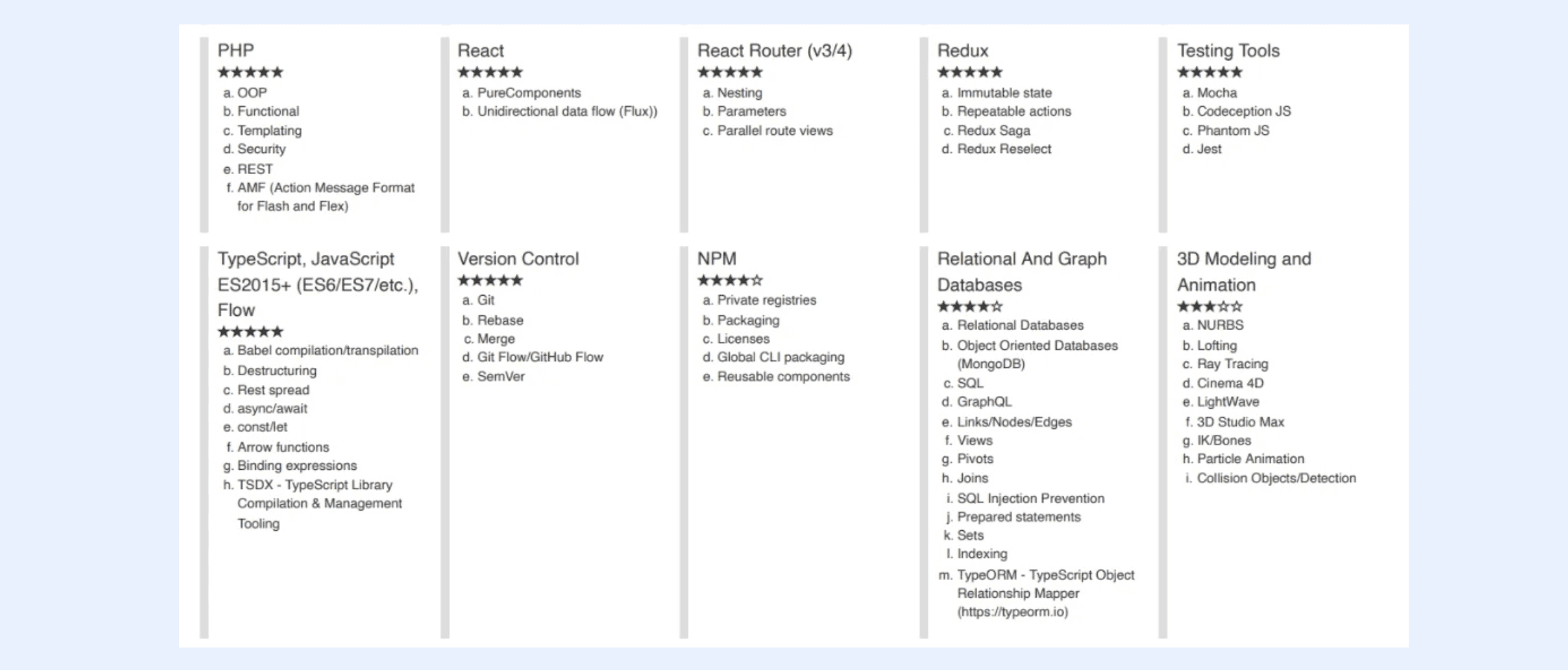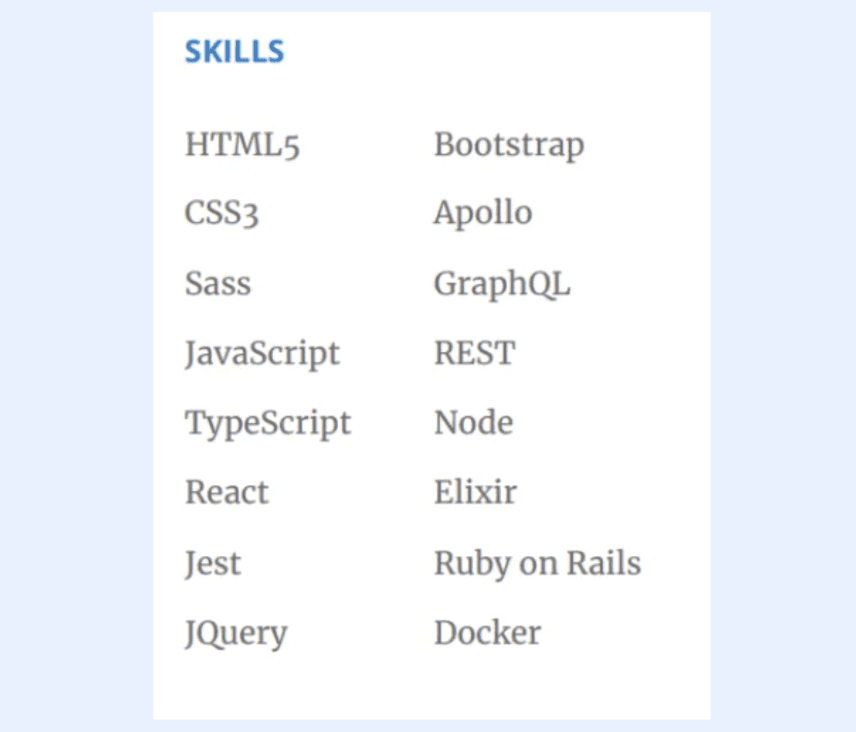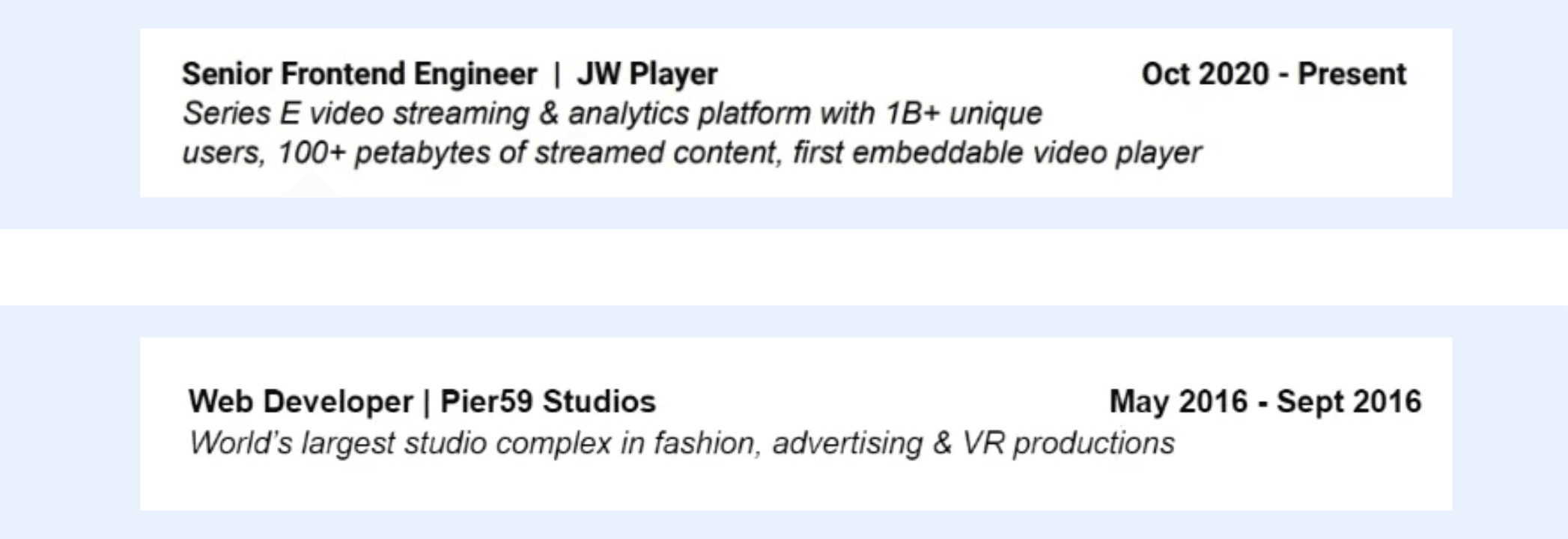
Suggested Sequence
Basics
Header
Skills
Professional Experience
📝 Basics
Do NOT use highly designed resume templates, they can mess up the resume upload process.
Use an 11-12 pt font for regular text and 14-16 pt for section titles.
Avoid repetition of verbs/phrases
It must be 1 page!!!
Export as a PDF with a clean title that includes your name, the resume, and the year.
👑 Header
Name: It is recommended that the name be set in a font size of 20 points. This standard font size is easy to read and will ensure that the name is visible and legible.
The contact line should include clickable LinkedIn, GitHub, and email links. The font size should be 11 points.
Include a super brief overview that includes some combo of your title/ type of role, years of experience, tech stack/area of focus & location (whatever fits the setup best).
Examples:
Zoe Lewtan | Senior Frontend Engineer with 7 years of experience
Senior Software Engineer (Full Stack | Typescript) based in Ontario, Canada

🤹♀️ Skills
Type of Skills
Technical Skills or Hard Skills:
Job-related skills are those that are necessary or enhance your ability to perform a job
These skills encompass your knowledge and proficiency in technology, programming and coding, software development, and product understanding, among others.
Non-Technical Skills or Soft Skills:
Soft skills refer to intangible qualities, including interpersonal and behavioral skills, that can enhance job performance.
Some examples of soft skills include leadership abilities, effective communication, creativity, innovation, problem-solving, and critical thinking.
If you aspire to a senior software engineering role, like an engineering manager, it's important to possess these soft skills to secure a high-level position.
Great Formats:

Weak Formats:


🏆 Professional Experience
1. Section Header:
Examples of context for the company:
“Series C influencer payments platform”
“Travel media website with 7M subscribers on YouTube”

2. Bullet Points:
Each bullet point should start with an action verb and be quantifiable wherever possible
Aim for 6 bullet points for the current role. Older jobs should have fewer, around 1-2.
Start with 1 bullet that describes your high-level contribution to the business. Scale gets extra credit here (ie, the platform used by thousands of Fortune 500 companies/millions of users). This helps companies get an idea of what they worked on, which explains the rest.
Bullet Formula:
Accomplished X as measured by Y by Doing Z
Action verb + accomplishment + outcome
STAR Method: Situation, Task, Action, Result. Briefly describe the situation, what your task was, the actions you took, and the results of those actions.
Bullet Points Structural Templates:
🏔 By Features/ Parts of the Product
API & Integrations: Technical Project Lead for a medium-sized project for the API team (of 10) to expand functionality on the API to improve scheduling workflows for partners. Integration used by 1000+ customers, 500k interviews scheduled in the past quarter.
Identity Management: Implemented single-sign for Google, Apple, and Facebook social platforms across web and iOS clients utilizing federated identities in Cognito.
⚒️ By Type of Engineering Work
Frontend Development in React: Creating reusable React components. Using styled components for styling. Creating a State management system based on Redux slices and supporting consistent user experience across the app.
Refactoring Frontend to React: from Ruby on Rails to React + TypeScript.
💥 By Role &/Or Impact
Drove changes to web infrastructure and deployment process for testing standards, increasing test stability and reducing runtime while increasing the frequency of testing. (6x tests, 10x runs a week, 10%-> 90+% reliability)
Created regression test suite for proxy API to ensure performance with legacy API
When possible, mention the reason you received a promotion or an increase in responsibilities
Promoted to SWE after successful design and automation of new partner integration onboarding and building program
For older roles, you can use even more of the context method rather than detailing your contributions.
Example:Led project for a high-performance game engine built on WebGL, a fully integrated automated test suite, advanced asset build, and optimization tools.
Framework-powered multiple online games with revenue between $2-4 million.
Tailor your resume for each application based on the company’s job description.
Analyze the Job Description: Carefully read the job posting and make a list of the key skills, experiences, and qualifications required. Look for specific keywords and phrases that are emphasized.
Match Your Skills and Experience: Align your resume with the job description by highlighting the most relevant skills and experiences you have. If the job requires specific technical skills or experience in a certain area, make sure these are prominent on your resume.
Use Keywords: Incorporate keywords from the job description into your resume. This is especially important for applications that go through Applicant Tracking Systems (ATS), which scan resumes for these keywords.
Extract keywords from the company's job description - https://monkeylearn.com/word-cloud/result
Add these keywords on your resume - you can use Chatgpt to help you incorporate those keywords on your bullet points
Customize Your Professional Summary: Adapt your professional summary at the top of your resume to reflect the key qualifications and skills sought in the job description. Make it clear why you're a great fit for this specific role.
Highlight Transferable Skills: If you're changing industries or roles, emphasize transferable skills that are relevant to the new job. For instance, project management or leadership skills can be valuable in many different roles.
Reorder Your Bullet Points: Rearrange the bullet points under each job in your work history to put the most relevant experiences first. This ensures the recruiter sees your most applicable experience right away.
Edit for Clarity and Brevity: Keep your resume concise and focused. Avoid including experiences or skills that are not relevant to the job you’re applying for.
Leopard.FYI on ChatGPT
You can also utilize Leopard.FYI on Chatgpt to enhance your resume. This AI assistant specializes in providing tailored advice to improve your resume. To get started, follow these steps:
Navigate to the Leopard.FYI on the Chatgpt webpage through the provided link: https://chat.openai.com/g/g-XFXEQOmYu-leopard-fyi.
Once you're on the webpage, you'll see a chat interface similar to Chatgpt.
In the chat window, type or paste the following prompt: "How can I improve my resume (upload pdf) using context about the companies I've worked at previously?"
Click on the "Upload PDF" button and select the PDF version of your resume from your device.
Hit the "Send" button to submit your resume and prompt to Leopard.FYI.
Impact Section of Resume Guide
In your resume, highlighting your impact in past roles is super important. Here’s what impact generally means to the employers we work with at Leopard:
You consistently achieve more than the average candidate.
You are assigned to significant projects and successfully deliver results.
You have the ability to discern what actions or initiatives will have a meaningful impact on the business, and what NOT to focus on / get distracted by
You can move quickly and efficiently to accomplish tasks.
If you're struggling to find the right words to describe your impact on your resume, you can start by using these ChatGPT prompts to make your existing bullets more impactful:
"Help me rephrase [FILL IN] to show more impact in a software engineering context."
"How can I describe my role doing [FILL IN] in a more impactful way?"
"What's a more impactful way to say '[FILL IN]
"My project improved customer satisfaction by 25%. How can I phrase this to highlight its impact on the company?"
"I reduced the time to deploy new features. Can you help me phrase this to show its impact on the business?"
Before jumping in and asking the AI to “improve” your resume, it can be helpful to see the different types of impact that startups care about in practical, real-life examples. Here are a bunch of examples of impact; while they all are effective to include, the early-stage companies tend to ask for the early-stage examples most often, and the like by stage.
Early Stage Impact: Fast-Paced Problem Solving & Building From Scratch
If you’ve worked in an early stage or zero-to-one environment (or want to work in that kind of environment in your next role), you should try to highlight your ability to quickly diagnose and resolve critical issues that impact business operations. Some examples:
Quick Adaptation to Changes: Showcasing the ability to adapt swiftly to changes in the market, technology, or business priorities.
Ex: "Collaborated with the founders to assess the emerging generative AI landscape, which led to realigning our engineering efforts to focus on high-demand features (data entry) that our customers needed.”
Rapid Prototyping Skills: Demonstrating your ability to quickly turn ideas into functional prototypes, and to deliver value with minimal resources
Ex: "Developed a functional MVP for our new AI note-taking product and got it in the hands of beta users just three weeks after uncovering their key need.”
Good Technical Judgement: Highlighting your ability to select and implement the most effective technologies for the startup's needs.
Ex: "Chose to build the app in Django, which made the AI note-taking features easier to spin up and test in days instead of weeks with Python”
Technical Leadership (Even on a Small Team): Highlighting your ability to provide technical leadership and strategic direction that aligns with the startup's needs.
Ex: Develop the MVP using Django, which let us rapidly iterate and test new features within days, as opposed to the weeks it would have taken with Python”
Versatile Skillset: Showcasing your ability to wear multiple hats and contribute across different areas of the business.
Ex: "Did all aspects of development (front-end development, back-end architecture, and database design) for the early stage fintech startup’s v1 mental health platform”
Series A/B Stage: Proactive Decision Making & Unlocking Growth
If you’ve worked in a growth stage environment (or want to work in that kind of environment in your next role), you should try to highlight your ability to make smart, informed decisions that meaningfully push the business forward. Some examples:
Product Development Work: Illustrating your contribution to the development or improvement of a product.
Ex: "I worked with 2 engineers on launching the mobile web version of the enterprise SaaS workflow platform, which was important given that 33% of users were logging in organically via mobile.”
Customer-Focused Engineering: Ensuring engineering decisions contribute to an exceptional customer experience.
Ex: "Developed a real-time monitoring system that proactively identified and resolved uploading issues, reducing new customer complaints by 20%”
Creative Problem Solving: Sharing unexpected ideas that ultimately work out.
Ex: “Developed a machine learning-powered recommendation engine that personalized user content, leading to a 50% increase in reactivations
Growth & Expansion Work: Highlighting your role in helping the company enter new markets, and segments, or generally unlock new user and/or customer growth.
Ex: "Spearheaded the expansion into the Latin American market, resulting in a 50% increase in regional sales and the acquisition of key strategic partnerships."
Direct Revenue Impact: Demonstrating how your actions directly contributed to increased revenue.
Ex: "Revamped the e-commerce checkout process for mobile web, resulting in a 20% increase in sales within the first month of implementation."
Strong Cross-Functional Skills: Ensuring that engineering decisions enhance product value and market fit.
Ex: "Led a cross-functional initiative to integrate AI-driven personalization into our platform, resulting in a 30% increase in MAUs & opening new revenue streams”
Automation Mindset: Demonstrating your ability to automate important processes and meaningfully improve operational efficiency.
Ex: "Automated repetitive tasks using scripting and workflow automation tools, freeing up 20 hours per week for the team to focus on strategic initiatives."
Meaningful Cost Reduction: Showcasing how you helped the company save money or reduce expenses.
Ex: "Implemented a new cloud storage solution, cutting monthly data storage costs by 50%, saving the company $150,000 annually."
Data-Driven Decision Making: Utilizing data and analytics to inform engineering strategies and product development.
Ex: “Implemented a data-driven analysis of user session lengths at Centered Mental Health, which led to the development of personalized therapy pathways within the UI. This approach resulted in a 35% increase in user engagement and a 25% improvement in reported mental well-being outcomes.”
Understanding of Business Operations: Highlighting improvements in processes or systems that led to more efficient operations across the business.
Ex: "Developed an automated reporting tool that reduced the time spent on monthly financial reporting by 70%, freeing up significant time for the finance team to focus on strategic initiatives."
Customer Satisfaction Impact: Showing how your work led to higher customer satisfaction or retention rates.
Ex: "Initiated a customer feedback loop that resulted in a 30% improvement in customer satisfaction scores and a 15% increase in customer retention."
Scaling Stage: Making Non-Trivial, High-Priority Improvements
If you’ve worked in a scaling environment (or want to work in that kind of environment in your next role), you should try to highlight the scale of what you’ve worked on, and what types of initiatives actually moved the needle in those environments. Some examples:
Long-Term Technical Thinking: Showing that you make good technical decisions that align with the company's long-term goals and market positioning.
Ex: "Championed the adoption of a serverless architecture, reducing operational costs by 40% and significantly improving scalability, aligning with our goal to become a market leader in cloud-native solutions for HR."
Quality Mindset: Highlighting your contribution to improving the quality of the product through rigorous testing and quality assurance practices.
Ex: "Introduced a comprehensive automated testing framework that decreased defect rates by 70% and significantly improved overall product quality."
Thoughtful Issue Prevention: Highlighting the ability to anticipate and address potential issues before they escalate, ensuring smooth operations.
Ex: "Implemented proactive monitoring tools that detected and resolved 90% of potential system issues before they impacted users, significantly improving system reliability."
Thoughtful Risk Management: Making informed decisions that balance innovation with risk mitigation.
Ex: "Implemented a phased rollout plan for a major system upgrade, minimizing downtime and ensuring a smooth transition, which preserved customer trust and avoided potential revenue loss from our biggest customer 1-800-FLOWERS.”
Security and Compliance: Prioritizing decisions that strengthened the security and compliance posture of the company.
Ex: Led the implementation of robust security protocols and compliance measures, securing our first enterprise contracts and positioning us as a trustworthy solution in the industry."
Meaningful Efficiency: Focusing on decisions that have a meaningful impact on the business’ operational efficiency and resource utilization.
Ex: "Optimized our CI/CD pipeline, reducing build times by 50% and enabling more frequent deployments, which accelerated our product iteration cycle."
Performance Optimization: Demonstrating how you improved the performance of a system or application.
Ex: "Optimized database queries for the company's core product, resulting in a 40% reduction in load times and a significantly enhanced user experience."
Technical Debt Reduction Impact: Demonstrating how you reduced technical debt and improved code maintainability.
"Refactored a legacy codebase, reducing technical debt by 60%, which resulted in a 30% increase in development speed for new features."
Infrastructure Expertise: Showcasing your efforts in automating infrastructure tasks to improve efficiency and reliability.
"Implemented a CI/CD pipeline that automated testing and deployment processes, reducing release cycle times by 50% and increasing deployment frequency by 200%."
Successful Architectural Decisions: Making architectural decisions that ensure the platform can handle growth and maintain high performance.
Ex: "Architected a scalable and resilient product recommendation infrastructure that supported a 300% increase in user traffic without compromising performance”
Bonus!!!
Ways to list employment gap in your resume:
More than 5 years ago = Don’t mention it
Under a year = Don’t mention it
Maternity Leave = Parental Leave
School = Educational Leave
Just couldn’t find a job = Personal Sabbatical
Laid Off = Post-Layoff Job Search
Family Issues = Family Care Leave
Health Issues = Family Care Leave
Travel = Travel Leave
You moved = Relocation Leave


